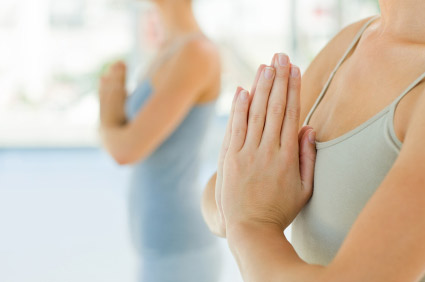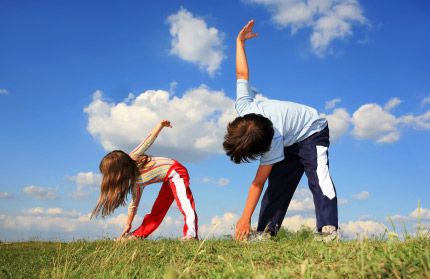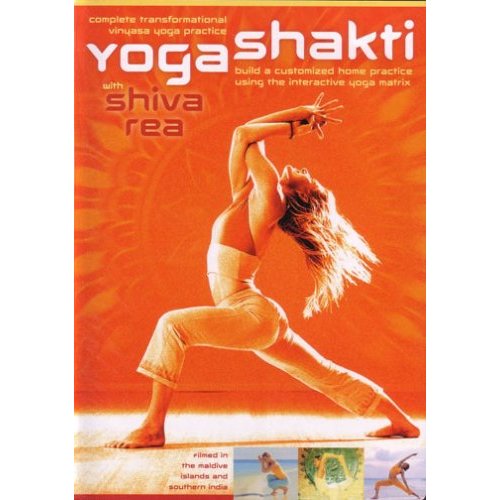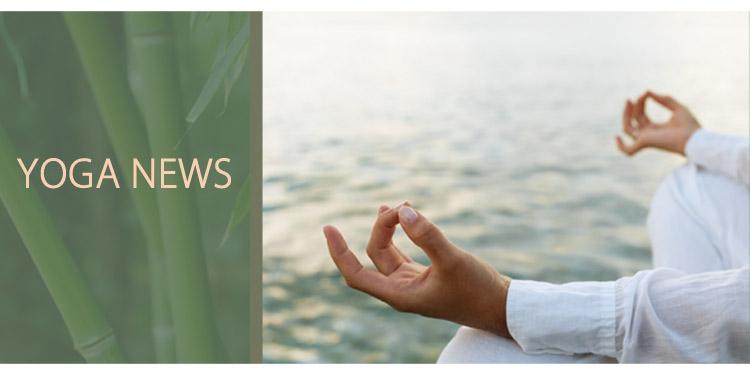 |
 |
|

The basis of many of the
yogic standing poses is Tadasana, or mountain pose. Much like a mountain, the
person in Tadasana will be surrounded by tranquility and will feel a heightened
impression of balance. The clarity and profound vision offered by mountain pose
will permit practitioners to go even deeper into their inner emotions and unite
with their inner selves on a deeper level. To get in mountain pose, start by
placing the heels slightly apart so that toes are parallel. Raise the ankles,
slowly tightening the leg muscles. Concentrate on moving your tailbone toward
the floor while simultaneously lifting your pelvic area toward the navel. Keep
your arms at your side by pushing your shoulder blades downward.
Tadasana is the first pose in sun salutations because the implication is that
the yoga practitioner should discover the meaning of balance and stillness
before progressing further. Tadasana channels energy flow throughout your
entire body, starting with the spine, then the back of the neck, followed by
the legs.
Trikonasana, or triangle pose, is another significant yogic standing pose.
Triangle pose stretches the spine laterally, a movement that complements later
forward poses. Straightness of the knees in triangle pose is essential, and
bending to the left and to the right should be attempted gradually. Triangle
pose provides a good foundation for the next series of postures which are a
little more challenging, and since it stimulates the spinal nerves, it helps
improve total body flexibility.
Positioning your body correctly in triangle pose will allow you to reap all of
the benefits of the pose. Start by spreading your feet far apart, with one foot
pigeon-toed. Next, stretch your arms parallel to the floor. Next, slightly bend
either to the left or right while fluidly sliding your hand down to your foot.
A good warm up session is essential before attempting triangle pose to prevent
strain of the lower back muscles. During triangle pose yogis often experience
the sensation of a lighter body combined with a feeling of warmth in the
stretched muscles.
|
|
 |
 |
|
 Om (pronounced "aum")
is a mantra or vibration often chanted 3 times at the beginning and 3 times at
the end of a yoga class. But what does that chant mean? "Om" is
actually a very simple chant with a complex meaning, representing the whole
universe in just one syllable. This fusion is very symbolic of the union of
mind, body, and spirit that happens during yoga practice. Knowing the
background of this sacred syllable will help you understand yoga even more,
helping you to delve deeper into your practice. Om (pronounced "aum")
is a mantra or vibration often chanted 3 times at the beginning and 3 times at
the end of a yoga class. But what does that chant mean? "Om" is
actually a very simple chant with a complex meaning, representing the whole
universe in just one syllable. This fusion is very symbolic of the union of
mind, body, and spirit that happens during yoga practice. Knowing the
background of this sacred syllable will help you understand yoga even more,
helping you to delve deeper into your practice.
Om is one of the most chanted syllables in India. The syllable is believed to
have a profound effect on the mind, body, and surroundings of the person that
speaks it. Somehow the ancient yogis knew what scientists today are telling
us-that the entire universe is moving, with nothing ever solid or still.
Everything in existence pulsates, creating a rhythmic vibration that the
ancient yogis acknowledged with the sound of Om. We may not always be aware of
this sound in our daily lives, but we can hear it in the sound of the waves on
the shore, the rustling of autumn leaves, even the sound of the ocean inside a
seashell.
Chanting Om allows yoga practitioners to recognize our experience as a
reflection of how the whole universe moves-the rising and setting of the sun,
the ebb and flow of the tides, the beating of our hearts. As we chant Om, it
establishes us in universal movement, practicing yoga and connecting us through
our breath, self-awareness, and physical energy. As we practice yoga and chant
"aaauuummm" at the beginning and ending of our practice, we begin to
sense a bigger connection to the universe that is both soothing and uplifting.
|
|
 |
 |
|
 If you're wondering if your
kids should practice yoga, the answer is a resounding "yes." You know
all the benefits you've received from your own yoga practice, and children reap
all the same benefits from yoga...and then some. Yoga helps develop the child's
brain and intellect, improving the powers of their concentration and focus. As
they learn how to challenge their bodies and the results that come from
quieting their minds and using them to power their body through yoga poses,
they'll expand their levels of creativity and imagination, not to mention
sharpen their awareness of their bodies and minds and the universe around them. If you're wondering if your
kids should practice yoga, the answer is a resounding "yes." You know
all the benefits you've received from your own yoga practice, and children reap
all the same benefits from yoga...and then some. Yoga helps develop the child's
brain and intellect, improving the powers of their concentration and focus. As
they learn how to challenge their bodies and the results that come from
quieting their minds and using them to power their body through yoga poses,
they'll expand their levels of creativity and imagination, not to mention
sharpen their awareness of their bodies and minds and the universe around them.
In addition to all of the mental benefits a yoga practice offers children, yoga
is also excellent for growing bodies, building strength and promoting balance,
flexibility, and coordination. Especially good yoga poses for children are
those postures that seem to instill balance, calm, and confidence. Children
need to go beyond just performing the posture and also need to understand the
meaning of the posture and to become like the posture - strong and confident as
a warrior, tall and limber like tree. Partner poses may also be taught to the
kids to help them develop trust and to encourage social development.
To get your children started with yoga, try having them join you near the end
of your practice - this will introduce them to yoga slowly, building up their
interest in it. Use positive reinforcement to encourage your children along in
their yoga practice, helping them learn the poses and emphasizing the
importance of breath. Demonstrate the pose you're trying to teach them, rather
than explaining it - here's where it's good to pop in a "yoga for kids"
DVD.
The sky is the limit when it comes to teaching children yoga, so using your
creativity is a good idea. Take your children through an imaginary African
safari, urging them to do tree pose, mountain pose, cobra pose, etc., as you
encounter them in your imaginary adventures. A new twist on an old favorite:
follow the leader is also a great way to introduce kids to yoga. Demonstrate
your favorite poses and encourage your children to mimic you, and as they learn
more poses you can switch places, letting the children show you their favorite
poses, while you follow along. An impromptu "yoga talent show" put on
for your family is a fun way to let kids demonstrate the poses they're
learning.
|
|
 |
 |
|
When most people hear the
term "strength training," they imagine a gym full of free weights,
complex machines, and the buff guys and girls who are using them, but how about
a yoga mat and your own body weight? Since strength training is defined as
exercise you perform against some kind of resistance, yoga qualifies - as many
yoga poses rely on the body's strength. In fact, yoga and weight-training
combined will create a stronger, leaner body with more endurance and a shorter
recovery time between workouts.
When you lift weights, it releases lactic acid, a waste product that sits in
muscles and causes you to still feel the burn from your workout days later. But
yoga flushes out excess lactic acid, decreasing stiffness and soreness, and
preparing you for your next day's workout. Yoga accomplishes this by
simultaneously stretching and strengthening your muscles, allowing for more
oxygen and blood flow, which flushes out toxins and the lactic acid that can
prevent you from going to the gym the day after a strenuous weight workout.
Most weightlifting workouts require you to do 6-12 repetitions of each set,
meaning your muscles will only contract for a period of between 24-48 seconds.
But with yoga, you may hold a pose for as long as five minutes or more. This
teaches your muscles to contract for longer periods of time, which can
drastically improve your muscular endurance, meaning they're less likely to
quit on you, whether you're on the yoga mat, in the gym lifting, or helping a
friend move some heavy furniture. Yoga teaches your muscles to work together
through a wide variety of angles -- making them stronger in your everyday life.
Lifting weights often fails to work all the body's muscles. Many weight lifters
concentrate only on the "mirror muscles" of the chest,
biceps/triceps, abs, and thighs, which can cause one side of the body to become
stronger than the other. But a complete yoga practice stretches and strengthens
all of your muscles, which helps improve your body's posture. Good posture
during weight lifting and many other activities will lessen your risk of injury
by keeping your spine in a natural state of alignment.
Whether you find yourself lifting weights more or devoting more time to a yoga
practice, a balance of the two is a good approach to fitness. There may be some
days when you'd prefer to lift at the gym, while others you may prefer to head
to the yoga studio or to practice at home on your own. Knowing some yoga poses
will come in handy when you're traveling or can't get to the gym... all you
need is your body, a mat, and an open mind.
|
|
 |
Your Name

800-123-4567
|
|
|
 |
|
In This Issue
|
|
 |
|
Updates from the studio
|
|
Your Name

800-123-4567
|

|
|
Yoga Shakti
|
|

Filmed
on location in India and the Maldive Islands on stunning digital video,
Yoga Shakti integrates tradition and modern innovation in a powerful
new learning system that evolves with the student. Viewers simply
select their favorite practices from a simple-to-use yoga menufilled
with a rich variety of moving postures, meditations, and shavasana
relaxationsand then press play to enjoy. To help them get started,
Shiva Rea includes a complete list of suggested sequences, ranging from
five-minute tune-up sessions to extended hour-long yoga immersions.
|

|
|
How to Take Your Yoga with You
|
|
Living a yogic life doesn't
have to end when you roll up your yoga mat and leave class. In fact, you can
carry the principles of yoga with you everywhere you go, and bring the
strength, awareness, and love you develop on your mat, and apply it to
virtually every aspect of your life outside the yoga studio. Here are some
principles you can practice to help you live a yogic life on and off the yoga
mat:
Set aside time for yourself.
Strive to feel more relaxed more often.
Trust yourself more.
Love all living beings.
Respect all life.
Cultivate peace in the world.
Do everything you can to protect the environment and the natural world.
Practice tolerance of all culture, nationalities, and religions.
|

|
|
Yoga Accessories Demystified
|
|
If you're a new to yoga, you may be a bit overwhelmed by the
different yoga accessories on the market now, but the great thing is, with yoga
becoming increasingly popular, there are more styles, varieties, and colors of
yoga accessories than ever before. Is a hot pink yoga mat what you crave? It
can happen. You can even order yoga mats with a personal photo printed on them.
Here are some of the most common yoga accessories that are a good investment
for anyone from a novice yogini to an advanced practitioner:
Yoga mat. Before you attempt yoga poses, make sure you've purchased a yoga mat
or are going to a yoga studio where you can rent or borrow one. The no-slip
surface will help to prevent injuries while you're holding poses. Depending on
the type of yoga you practice, you may opt for an extra thick mat (for power
yoga) or, if you're especially tall, an extra long variety of mat. Take
advantage of the wide variety of yoga mats on the market to choose the color and
style that suits you best.
Yoga block. Made of foam, wood, cork, or bamboo, yoga blocks bolster your hands
when you're not flexible enough to touch the floor. Arms not long enough or
flexible enough to reach the floor in triangle pose? Here's where a yoga block
comes in handy.
Yoga straps. Yoga straps are typically made of nylon and will help you add
resistance to a pose without losing your form.
Yoga blankets. often colorful and soft, are used to lend support in yoga
positions, and add extra comfort and warmth during final relaxation. Choose a
high quality yoga blanket that will stand up to repeated washing.
Yoga bags. these are usually available
in a zippered or drawstring style and are designed to hold your rolled up yoga
mat, any props you wish to use, and a number of other personal belongings. Yoga
bags are a convenient way to pack up all the things you need so all you have to
do on your way out to class is grab your yoga bag.
|
|
 |

